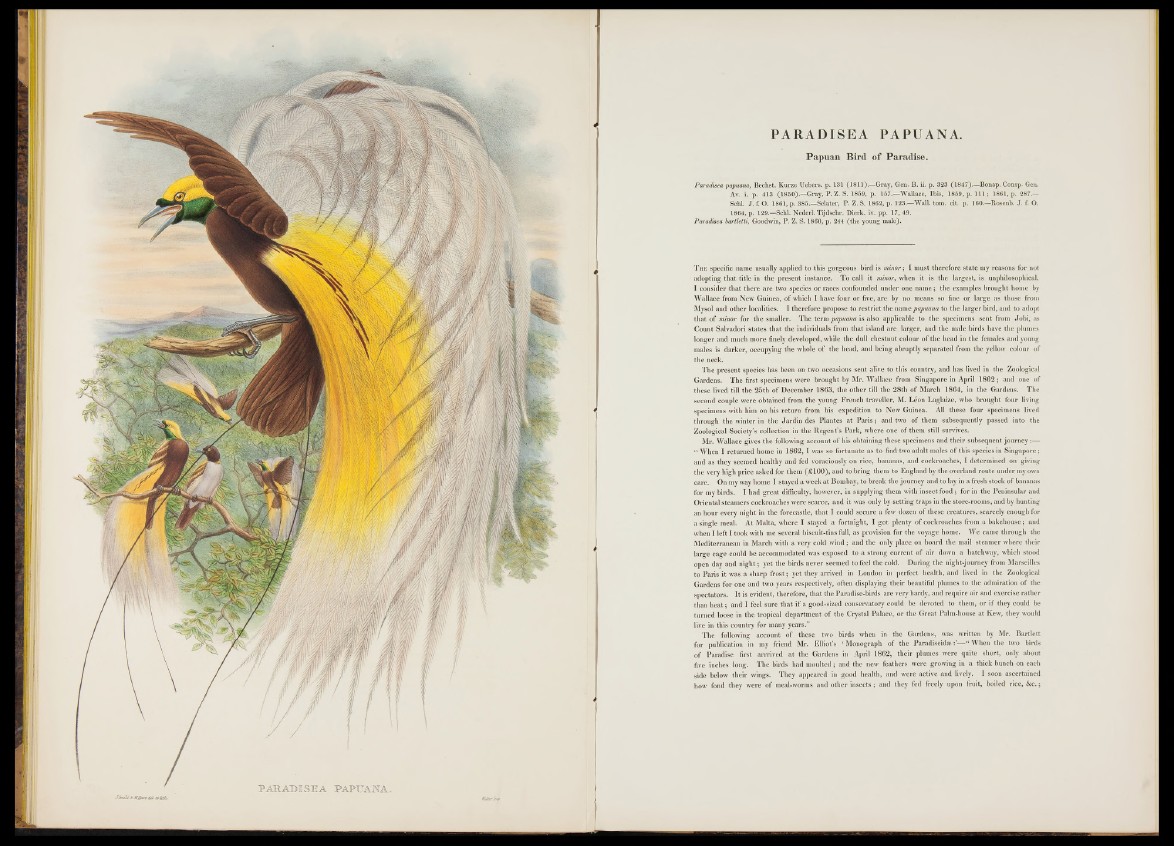
PA RA D ISEA PAPUANA.
WBar&ielaàlh-
Papuan Bird of Paradise.
Paradisea papuana, Bechst. Kurze Uebers. p. 131 (1 8 1 1 ).—Gray, Gen. B . ii. p. 323 (1 8 4 7 )— Bonap. Consp. Gen.
Av. i. p. 413 (1 8 5 0 ).—Gray, P. Z. & 1859, p. 1 5 7—Wallace, Ibis, 1869, p. I l i ; 1861, p. 287.—
Sebi. J. f. O. 1861, p. 385.—Sclater, P. Z. S. 1862, p. 123.—Wall. tona. cit. p. 160.—Rosenb. J. f. 0 .
1864, p. 129.—Schl. Nederl. Tijdscbr. Dierk. iv. pp. 17, 49.
Paradisea bariletti, Goodwin, P. Z. S. 1860, p. 244 (the young male).
T he specific name usually applied to this gorgeous bird is minor; I must therefore state my reasons for not
adopting that title in the present instance. To call it minor, when it is the largest, is unphilosophical.
I consider that there are two species or races confounded under one name; the examples brought home by
Wallace from New Guinea, of which I have four or five, are by no means so fine or large as those from
Mysol and other localities. I therefore propose to restrict the name papuana to the larger bird, and to adopt
that o f minor for the smaller. The term papuana is also applicable to the specimens sent from Jobi, as
Count Salvadori states that the individuals from that island are larger, and the male birds have the plumes
longer and much more finely developed, while the dull chestnut colour o f the head in the females and young
males is darker, occupying the whole of the head, and being abruptly separated from the yellow colour of
the neck.
The present species has been on two occasions sent alive to this country, and has lived in the Zoological
Gardens. The first specimens were brought by Mr. Wallace from Singapore in April 1862; and one of
these lived till the 25th o f December 1863, the other till the 28th o f March 1864, in the Gardens. The
second couple were obtained from the young French traveller, M. Leon Laglaize, who brought four living
specimens with him on his return from his expedition to New Guinea. All these four specimens lived
through the winter in the Jardin des Plantes at Paris; and two o f them subsequently passed into the
Zoological Society’s collection in the Regent’s Park, where one o f them still survives.
Mr. Wallace gives the following account o f his obtaining these specimens and their subsequent journey
“ When I returned home in 1862, I was so fortunate as to find two adult males o f this species in Singapore;
and as they seemed healthy and fed voraciously on rice, bananas, and cockroaches, I determined on giving
the very high price asked for them (£ 1 0 0 ), and to bring them to England by the overland route under my own
care.. On my way home I stayed a week at Bombay, to break the journey and to lay in a fresh stock o f bananas
for my birds. I had great difficulty, however, in supplying them with insect food; for in the Peninsular and
Oriental steamers cockroaches were scarce, and it was only by setting traps in the store-rooms, and by hunting
an hour every night in the forecastle, that I could secure a few dozen o f these creatures, scarcely enough for
a single meal. At Malta, where I stayed a fortnight, I got plenty o f cockroaches from a bakehouse; and
when I left I took with me several biscuit-tins full, as provision for the voyage home. We came through the
Mediterranean in March with a very cold wind; and the only place on board the mail steamer where their
large cage could be accommodated was exposed to a strong current o f air down a hatchway, which stood
open day and night; yet the birds never seemed to feel the cold. During the uight-journey from Marseilles
to Paris it was a sharp frost; yet they arrived in London in perfect health, and lived in the Zoological
Gardens for one and two years respectively, often displaying their beautiful plumes to the admiration o f the
spectators. It is evident, therefore, that the Paradise-birds are very hardy, and require air and exercise rather
than heat; and I feel sure that if a good-sized conservatory could be devoted to them, or if they could be
turned loose in the tropical department o f the Crystal Palace, or the Great Palm-house at Kew, they would
live in this country for many years.”
The following account o f these two birds when in the Gardens, was written by Mr. Bartlett
for publication in my friend Mr. Elliot’s ‘Monograph o f the Paradiseidae:’— “ When the two birds
of Paradise first arrrived at the Gardens in April 1862, their plumes were quite short, only about
five inches long. The birds had moulted; and the new feathers were growing in a thick bunch on each
side below their wings. They appeared in good health, and were active and lively. I soon ascertained
how fond they were o f meal-worms and other insects; and they fed freely upon fruit, boiled rice, &c.;